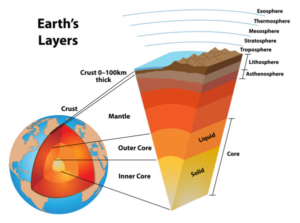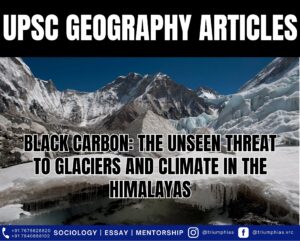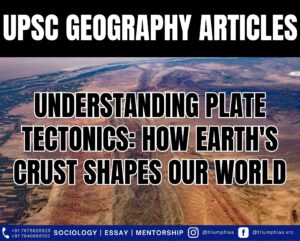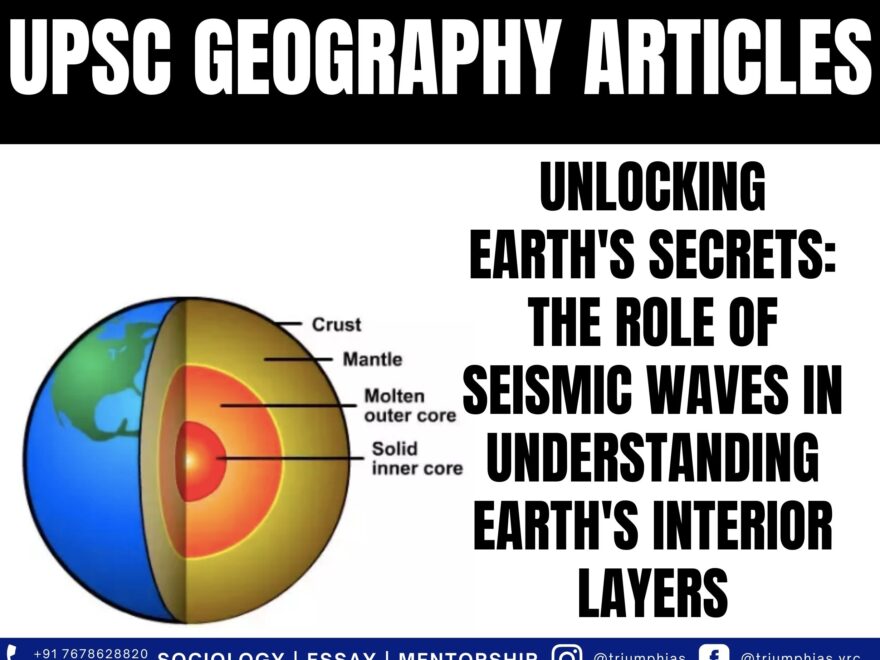Layers of Earth
(Relevant for Geography Section of General Studies Paper Prelims/Mains)

Layers of earth: role of seismic waves in the study of the interior of earth.
On the basis of seismic investigations, the earth can be divided into three major layers: crust, mantle, core.
Differentiation of layers of Earth
Earth Structure:
- Crust: The Earth’s outermost layer is referred to as the “crust.” In regions with continents, the crust can be categorized into two distinct layers. The upper layer, characterized by its lower density and granitic composition, is known as the “sial.” Conversely, the lower layer, consisting of basaltic composition, is termed “sima.” This division extends approximately 30 to 40 kilometers beneath continental areas and about 10 kilometers beneath ocean basins.
- Mantle: Beneath the Earth’s crust lies the mantle, which has a thickness of approximately 2900 kilometers. The mantle can be segmented into two layers: (i) the upper mantle and (ii) the lower mantle. The demarcation between these layers occurs around 700 kilometers beneath the surface. An integral zone within the upper mantle is the “asthenosphere,” situated at depths ranging from 50 to 100 kilometers. This zone plays a pivotal role in supplying lava for volcanic activities.
- Core: The Earth’s core, comprising both the inner core and the outer core, occupies merely 16 percent of the planet’s volume yet contributes to 33 percent of its mass. Similar to the mantle, the core can be delineated into two layers: the outer core and the inner core. The outer core is composed of a mixture of iron, nickel, and trace quantities of lighter elements. Due to the insufficient pressure exerted on the outer core, it remains in a liquid state, despite sharing a composition akin to that of the inner core.
The study of the passage of seismic waves through the earth has helped in knowing the structure of the earth’s interior and in defining the physical properties of various layers. For example:
- The “outer core” was discovered when it was found that P-waves were bent inwards thereby producing a “shadow zone” at the surface.
- Since the S-waves do not pass through the outer core, it is concluded that it may be in the liquid state.
Seismic waves travel different velocities depending on the nature of the layer in which they are travelling. Thus they not only indicate the position of each layer but also give clues as to its composition.
Sample Question for UPSC Sociology Optional Paper:
Question 1: What are the major layers of the Earth’s interior?
Short Answer: The Earth’s interior is primarily divided into three major layers: the crust, the mantle, and the core.
Question 2: How do seismic waves help in the study of Earth’s interior?
Short Answer: Seismic waves help in the study of Earth’s interior by providing data on the speed and direction of wave travel. This information enables scientists to deduce the composition and properties of various layers, such as the presence of a liquid outer core.
Question 3: Explain the concept of the “shadow zone” in seismic studies.
Short Answer: The “shadow zone” refers to the area where seismic waves, particularly P-waves, are bent inwards and do not reach, revealing information about the composition of Earth’s layers like the outer core.
Question 4: What role does the asthenosphere play in Earth’s geology?
Short Answer: The asthenosphere, located within the upper mantle, is a zone that plays a critical role in plate tectonics and supplies lava for volcanic activities.
Question 5: How does the velocity of seismic waves vary across different layers of Earth?
Short Answer: The velocity of seismic waves changes depending on the nature and composition of the layer they travel through. For example, S-waves do not travel through the outer core, suggesting it is liquid, while P-waves are refracted due to changes in density and composition.
 |
 |
To master these intricacies and fare well in the Sociology Optional Syllabus, aspiring sociologists might benefit from guidance by the Best Sociology Optional Teacher and participation in the Best Sociology Optional Coaching. These avenues provide comprehensive assistance, ensuring a solid understanding of sociology’s diverse methodologies and techniques.
Seismic waves, Earth’s interior, Earth’s layers, Crust, Mantle, Core, Geology, Geography, Earth Science, Asthenosphere, P-waves, S-waves, Shadow zone, Earth Structure, Seismic waves, Earth’s interior, Earth’s layers, Seismic waves, Earth’s interior, Earth’s layers, Seismic waves, Earth’s interior, Earth’s layers,

Choose The Best Sociology Optional Teacher for IAS Preparation?
At the beginning of the journey for Civil Services Examination preparation, many students face a pivotal decision – selecting their optional subject. Questions such as “which optional subject is the best?” and “which optional subject is the most scoring?” frequently come to mind. Choosing the right optional subject, like choosing the best sociology optional teacher, is a subjective yet vital step that requires a thoughtful decision based on facts. A misstep in this crucial decision can indeed prove disastrous.
Ever since the exam pattern was revamped in 2013, the UPSC has eliminated the need for a second optional subject. Now, candidates have to choose only one optional subject for the UPSC Mains, which has two papers of 250 marks each. One of the compelling choices for many has been the sociology optional. However, it’s strongly advised to decide on your optional subject for mains well ahead of time to get sufficient time to complete the syllabus. After all, most students score similarly in General Studies Papers; it’s the score in the optional subject & essay that contributes significantly to the final selection.
“A sound strategy does not rely solely on the popular
Opinion of toppers or famous YouTubers cum teachers.”
It requires understanding one’s ability, interest, and the relevance of the subject, not just for the exam but also for life in general. Hence, when selecting the best sociology teacher, one must consider the usefulness of sociology optional coaching in General Studies, Essay, and Personality Test.
The choice of the optional subject should be based on objective criteria, such as the nature, scope, and size of the syllabus, uniformity and stability in the question pattern, relevance of the syllabic content in daily life in society, and the availability of study material and guidance. For example, choosing the best sociology optional coaching can ensure access to top-quality study materials and experienced teachers. Always remember, the approach of the UPSC optional subject differs from your academic studies of subjects. Therefore, before settling for sociology optional, you need to analyze the syllabus, previous years’ pattern, subject requirements (be it ideal, visionary, numerical, conceptual theoretical), and your comfort level with the subject.
This decision marks a critical point in your UPSC – CSE journey, potentially determining your success in a career in IAS/Civil Services. Therefore, it’s crucial to choose wisely, whether it’s the optional subject or the best sociology optional teacher. Always base your decision on accurate facts, and never let your emotional biases guide your choices. After all, the search for the best sociology optional coaching is about finding the perfect fit for your unique academic needs and aspirations.
To master these intricacies and fare well in the Sociology Optional Syllabus, aspiring sociologists might benefit from guidance by the Best Sociology Optional Teacher and participation in the Best Sociology Optional Coaching. These avenues provide comprehensive assistance, ensuring a solid understanding of sociology’s diverse methodologies and techniques. Sociology, Social theory, Best Sociology Optional Teacher, Best Sociology Optional Coaching, Sociology Optional Syllabus.
Best Sociology Optional Teacher, Sociology Syllabus, Sociology Optional, Sociology Optional Coaching, Best Sociology Optional Coaching, Best Sociology Teacher, Sociology Course, Sociology Teacher, Sociology Foundation, Sociology Foundation Course, Sociology Optional UPSC, Sociology for IAS,
Follow us :
🔎 https://www.instagram.com/triumphias
🔎https://www.youtube.com/c/TriumphIAS
https://t.me/VikashRanjanSociology
Find More Blogs
|
Scope of the subject and comparison with other social sciences |
|||
|
|
|
|
Modernity and social changes in Europe |

